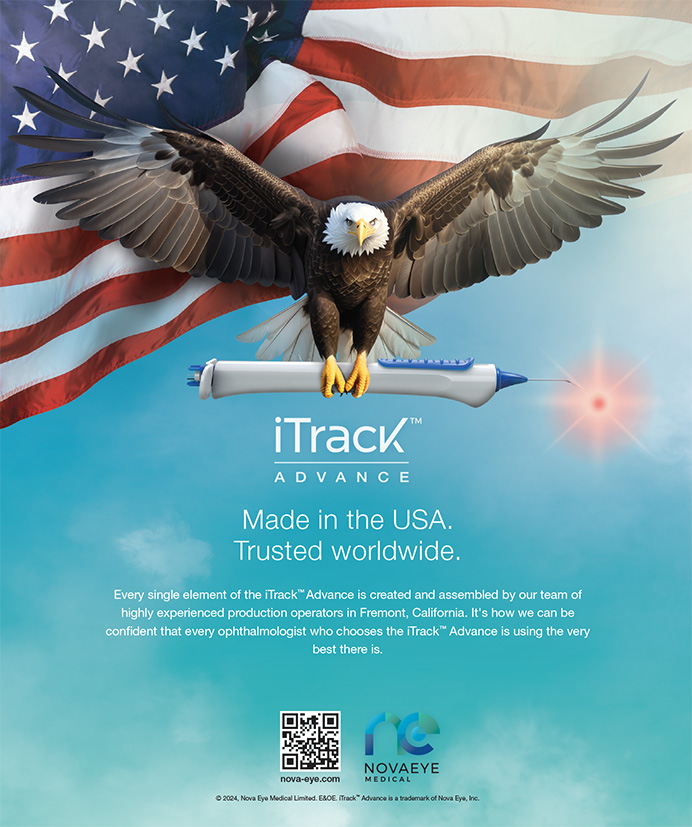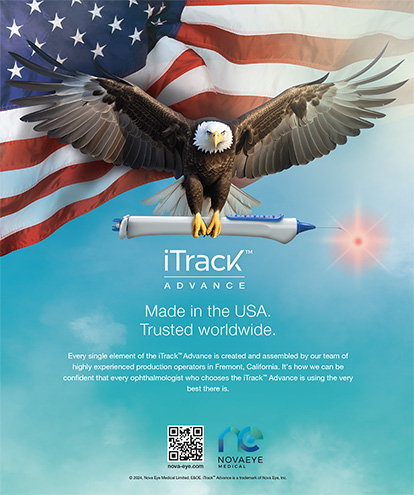Patients’ satisfaction constitutes cataract surgeons’ most important surgical outcome. In general, someone’s satisfaction with anything can be measured in a simple, straightforward way by asking, “Would you do it again?” This question may, in fact, be posed as a measure of effectiveness in a Premarket Approval Application submitted to the FDA. For example, in the Summary of Safety and Effectiveness Data for the Tecnis Multifocal IOL (Abbott Medical Optics Inc., Santa Ana, CA), 94.6% of the 112 subjects responded 1 year after surgery that they would “elect the IOL again.”1 Because many factors combine to create a sense of satisfaction, the use of a control group in the evaluation of any new technology becomes critical. A monofocal IOL served as the control in this particular Premarket Approval Application; 89.6% of the 115 control subjects stated they would “elect the IOL again.”
Despite the inherent appeal of using a single question to measure satisfaction, asking one question at a single time point represents a simplistic approach. In fact, satisfaction may be transitory. For example, the gradual development of posterior capsular opacification may subtly degrade optical quality and engender dissatisfaction (especially if the patient is unaware of the cause of the change in vision and its potential reversibility). Furthermore, no experience in people’s memories remains unalloyed. Human beings may want to repeat certain aspects of an experience but not others. Therefore, a simple expression of satisfaction remains ambiguous, potentially idiosyncratic, and certainly multifactorial. Despite these uncertainties, key drivers of satisfaction lead to positive surgical outcomes.
THE FIVE KEY DRIVERS OF
PATIENTS’ SATISFACTION
The first criterion for satisfaction is the establishment of the doctor-patient relationship. Communication sets the stage for success. Understanding the patient’s needs and communicating appropriate expectations underpin any future possibility of satisfying him or her.
Second, an accurate diagnosis entails the deployment of both strategic medical knowledge and intuition. Diagnostic procedures include the history, the physical examination, and multiple technical measurements, ranging from tear breakup time and corneal topography to axial length measurements and optical coherence tomography.
Third, medical decision making and informed consent follow from all of the information that has been collected and verified.
Fourth, in the OR, advanced technology and flawless technique must combine to deliver the desired outcome.
Fifth, the postoperative period may require the surgeon’s dedication and perseverance along with an honest, “egoless” appraisal if the course does not proceed as expected. The surgeon may still satisfy the patient despite the need for prolonged medical care or surgical re-intervention, but the process will try the trust and understanding fostered at the initiation of the doctor-patient relationship.
SAFETY AND EFFECTIVENESS
Although success may be measured purely in terms of patients’ satisfaction, it can be helpful to break the former down further into safety and effectiveness. These elements provide surgeons with more precisely defined goals to help guide their choice of innovative surgical solutions. When I think of the safety and effectiveness of phacoemulsification in the performance of refractive cataract surgery, for example, I include the following categories.
The “Wow” Effect
The well-known “wow” depends upon the patient’s experiencing a more rapid improvement in vision than expected. Six years ago, my colleagues and I published an article examining the effect of various new phaco systems on the patient’s UCVA at the first postoperative examination. 2 The use of acuity on postoperative day 1 exemplifies the importance of immediate results in satisfying patients, and it provides a benchmark for evaluating new technology. 3 Although most of the specific innovations described in our 2004 article have already become obsolete, the trend toward the decreased use of ultrasound through phaco power modulations has remained consistent. Keeping track of uncorrected acuity on day 1 as surgeons modify their technique or change their phaco machine settings represents a straightforward approach to measuring the “wow” factor. Of course, surgeons must exclude (and appropriately counsel) patients with concomitant ocular pathology or a history of incisional keratorefractive surgery or LASIK.4
As outcomes have improved, the assessment of results has become more sophisticated. For example, Denoyer et al compared biaxial microincisional and coaxial smallincision cataract surgery. They found no difference in visual acuity, refraction, or corneal astigmatism between the groups. In contrast, the investigators noted that the total ocular higher-order root mean square (RMS) (P = .002), third-order trefoil RMS (P < .001), trefoil-like RMS (P < .001), and fifth-order RMS (P < .001) were lower in the biaxial versus coaxial eyes. Also, the study revealed that corneal aberrations were positively correlated with ocular aberrations for the RMS of third- to sixth-order aberrations, third-order trefoil, and spherical-like aberrations. 5 Whether these statistically significant differences in wavefront measurements correlate with patients’ satisfaction, however, has not been demonstrated.
The Complication Rate
Complications of phacoemulsification per se generally include unintended anatomical disruptions, which may lead to corneal edema, uveitis, glaucoma, retinal detachment, or endophthalmitis. A spectrum of morbidity spans the surgical experience. Some ophthalmologists may feel completely comfortable with a UCVA of 20/40, 1+ peripheral endothelial striae in the area of the incision, trace cells, and an IOP of 24 mm Hg on day 1. Anything worse would make them wince. That professional angst defines a complication. It is any intraoperative or postoperative occurrence or finding that causes discomfort for the surgeon or the patient or that necessitates a change in plans.
IOL manufacturers and clinical investigators are familiar with the FDA grid that represents a standardized list of benchmarks for complications of cataract surgery (FDA Defined Cumulative and Persistent Adverse Events). An example may be found in the Summary of Safety and Effectiveness Data for any approved IOL.6 For example, the grid lists the cumulative 1-year incidence of endophthalmitis as 0.1%, that of cystoid macular edema as 3.0%, and that of secondary surgical intervention as 0.8%. How many surgeons know their complication rates? Every cataract surgeon is prey to the availability heuristic, which means that ophthalmologists tend to estimate the frequency of a given complication based on how easily they can bring an example to mind.7 The value of knowing the actual statistics lies in the surgeon’s ability to objectively evaluate the results of technological innovation rather than rely on anecdotal evidence (even if the anecdote is his or her own).
Can et al recently published their experience comparing standard coaxial, microcoaxial, and biaxial microincisional cataract surgery (MICS). Complications included
Posterior capsule rupture in 1 eye (2.2%) each in the standard coaxial group and the biaxial MICS group and iris prolapse through the incision site in 1 eye (2.2%) in the microcoaxial group and 2 eyes (4.4%) in the biaxial MICS group; the difference between groups was not statistically significant (P = .602 and P = .360, respectively; Pearson chi-square test). No eye had vitreous loss, and all eyes had successful intraocular lens (IOL) implantation in the capsular bag. Postoperative complications were anterior chamber inflammation that resolved with treatment in 2 eyes (4.4%) and posterior capsule opacification in 1 eye (2.2%) in the biaxial MICS group; the difference between groups was not statistically significant (P =.131 and P = .602, respectively; Pearson chi-square test).8
The results reported by Can et al have value, because the absence of statistically significant differences demonstrates that these three surgical techniques have equivalent safety profiles. The choice of technique, therefore, should be made on other grounds. (Can et al conclude, “biaxial microincision surgery, with the smallest incisions, induced less astigmatism and reduced all intraoperative phaco parameters except total surgical time.”8)
The Surgical Experience
Phaco surgeons share a set of skills and knowledge that, in many ways, represents their professional identity and facilitates their mastery of the surgical procedure and the operating environment. They intuitively know the feeling of a surgery that is going well, as opposed to one that is not.9 In this realm, statistics do not apply, and the ophthalmologist alone is the judge. The learning curve, however, must be respected; many surgeons appear not to want to try anything new or go outside their comfort zone precisely because they see the learning curve as a cliff. It helps if they can evaluate a new idea as a thought experiment and see the logic behind it or give it a try in a model.10
CONCLUSION
New technology may feel intimidating. By keeping track of their outcomes and organizing their data in terms of effectiveness, safety, and direct experience, surgeons can choose what to adopt and what to let go. As written in The Book of Changes,
We must look back upon our conduct and its consequences. If the effects are good, then good fortune is certain. No one knows himself. It is only by the consequences of his actions, by the fruit of his labors, that a man can judge what he is to expect.11
Mark Packer, MD, is a clinical associate professor at the Casey Eye Institute, Department of Ophthalmology, Oregon Health and Science University, and he is in private practice with Drs. Fine, Hoffman & Packer, LLC. He is a consultant to Abbott Medical Optics Inc. Dr. Packer may be reached at (541) 687-2110; mpacker@finemd.com.
- U.S.Food and Drug Administration.Tecnis Multifocal Foldable Silicone and Acrylic Intraocular Lenses - P080010. http://www.fda.gov/MedicalDevices/ProductsandMedicalProcedures/DeviceApprovalsandClearances/Recently- ApprovedDevices/ucm081891.htm.Updated July 8,2009.Accessed June 6,2010.
- Fine IH,Packer M,Hoffman RS.Power modulations in new phacoemulsification technology:improved outcomes.J Cataract Refract Surg.2004;30(5):1014-1019.
- Osher RH.Microcoaxial phacoemulsification part 2:clinical study.J Cataract Refract Surg.2007;33(3):408-412.
- Packer M,Brown LK,Hoffman RS,Fine IH.Intraocular lens power calculation after incisional and thermal keratorefractive surgery. J Cataract Refract Surg.2004;30(7):1430-1434.
- Denoyer A,Denoyer L,Marotte D,et al.Intraindividual comparative study of corneal and ocular wavefront aberrations after biaxial microincision versus coaxial small-incision cataract surgery.Br J Ophthalmol.2008;92(12):1679-1684.
- Guidance for industry and FDA reviewers.Intraocular lens guidance document. http://www.fda.gov/OHRMS/DOCKETS/98fr/994052qd.pdf.Accessed July 12,2010.
- Tversky A,Kahneman D.Availability:a heuristic for judging frequency and probability.Cogn Psychol.1973;5:207-232.
- Can I,Takmaz T,Yildiz Y,et al.Coaxial,microcoaxial,and biaxial microincision cataract surgery:prospective comparative study.J Cataract Refract Surg.2010;36(5):740-746.
- Smith JH.Surgical intuition—the scientific basis of expert wisdom.Video Journal of Ophthalmology.Third quarter 2009.https://mediamillinc.com/vjo.php?display=back%20issues.Accessed July 12,2010.
- Packer M,Fine IH.Opening your mind to new ideas.http://www.finemd.com/theexpertview/?p=44.Published April 25,2009.Accessed June 6,2010.
- Wilhelm R,Baynes CF.Treading (conduct).In:The Book of Changes.3rd ed.Bollingen Series XIX.Princeton,NJ: Princeton University Press;1967.http://www.akirarabelais.com/i/i.html.Accessed June 6,2010.


